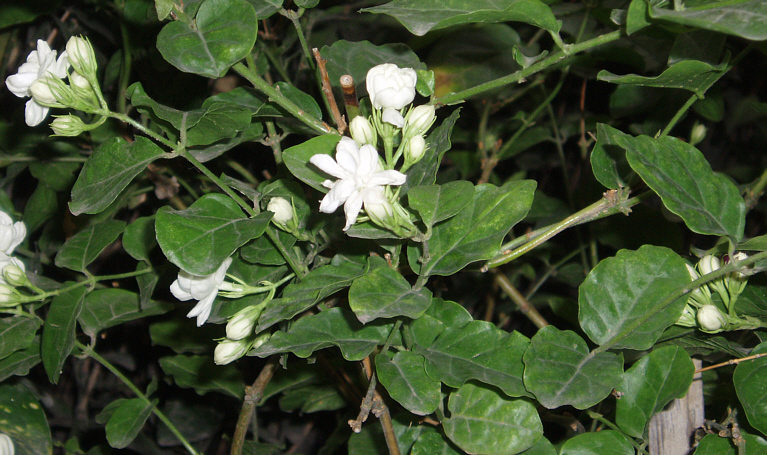

Zitierweise / cite as:
Carakasaṃhitā: Ausgewählte Texte aus der Carakasaṃhitā / übersetzt und erläutert von Alois Payer <1944 - >. -- Anhang A: Pflanzenbeschreibungen. -- Jasminum sambac (L.) Aiton. -- Fassung vom 2007-07-27. -- URL: http://www.payer.de/ayurveda/pflanzen/jasminum_sambac.htm
Erstmals publiziert: 2007-07-27
Überarbeitungen:
Anlass: Lehrveranstaltung SS 2007
©opyright: Dieser Text steht der Allgemeinheit zur Verfügung. Eine Verwertung in Publikationen, die über übliche Zitate hinausgeht, bedarf der ausdrücklichen Genehmigung des Verfassers
Dieser Text ist Teil der Abteilung Sanskrit von Tüpfli's Global Village Library
WARNUNG: dies ist der Versuch einer
Übersetzung und Interpretation eines altindischen Textes. Es ist keine
medizinische Anleitung. Vor dem Gebrauch aller hier genannten Heilmittel wird
darum ausdrücklich gewarnt. Nur ein erfahrener, gut ausgebildeter ayurvedischer
Arzt kann Verschreibungen und Behandlungen machen!
Falls Sie die diakritischen Zeichen nicht dargestellt bekommen, installieren Sie eine Schrift mit Diakritika wie z.B. Tahoma.
Verwendete und zitierte Werke siehe: http://www.payer.de/ayurveda/caraka0001.htm

Abb.: Jasminum sambac (L.) Aiton = Arabischer Jasmin
[Bildquelle: Wikipedia]
Drury:
"Jasminum sambac (Ait.) Do. Tajeregam - mulla, Mal. Pun-mullika, Mal. Kody-mulli, Tam. Boondoomallie, Tel. But-moogra, Beng.
Description. — Twining shrub ; leaves opposite, cordate, ovate or oblong, waved, sometimes scolloped, pointed, smooth, downy on the veins on the under side; calyx segments 5-9; flowers terminal, generally in small trichotomous umbellets, white. Fl. March---May.—Roxb, Fl. Ind. i. 88.— Wight Icon. t. 704.—Nyctanthes Sambac, Linn.-------Common everywhere.
Medical Uses.—Of this there are two other varieties: the double-flowered Jasmin, called Beta in Bengal—the Nulla mulla of Rheede
(vi. t. J50); and the Buro-bel and Kadda mulla of Rheede (vi. t. 51). The plant is common in every forest in the Peninsula, and is generally cultivated in gardens. The leaves if boiled in oil exude a balsam which is used for anointing the head in eye-complaints. It is said to strengthen the vision. An oil is also expressed from the roots used medicinally. The flowers, commonly known as the Moogree flowers, are sacred to Vishnoo.—(Rheede.) The flowers possess considerable power as a lactifuge, and are effectual in arresting the secretion of milk in the puerperal state, in cases of threatened abscess. For this purpose about two or three handfuls of the flowers bruised and unmoistened are applied to each breast, and renewed once or twice a-day. The secretion is sometimes arrested in about twenty-four hours, though it generally requires two or even three days.—Pharm. of India."
[Quelle: Drury, Heber <1819 - 1872>: The useful plants of India : with notices of their chief value in commerce, medicine, and the arts. -- 2d ed. with additions and corrections. London : Allen, 1873. -- xvi, 512 p. ; 22 cm. -- s.v.]